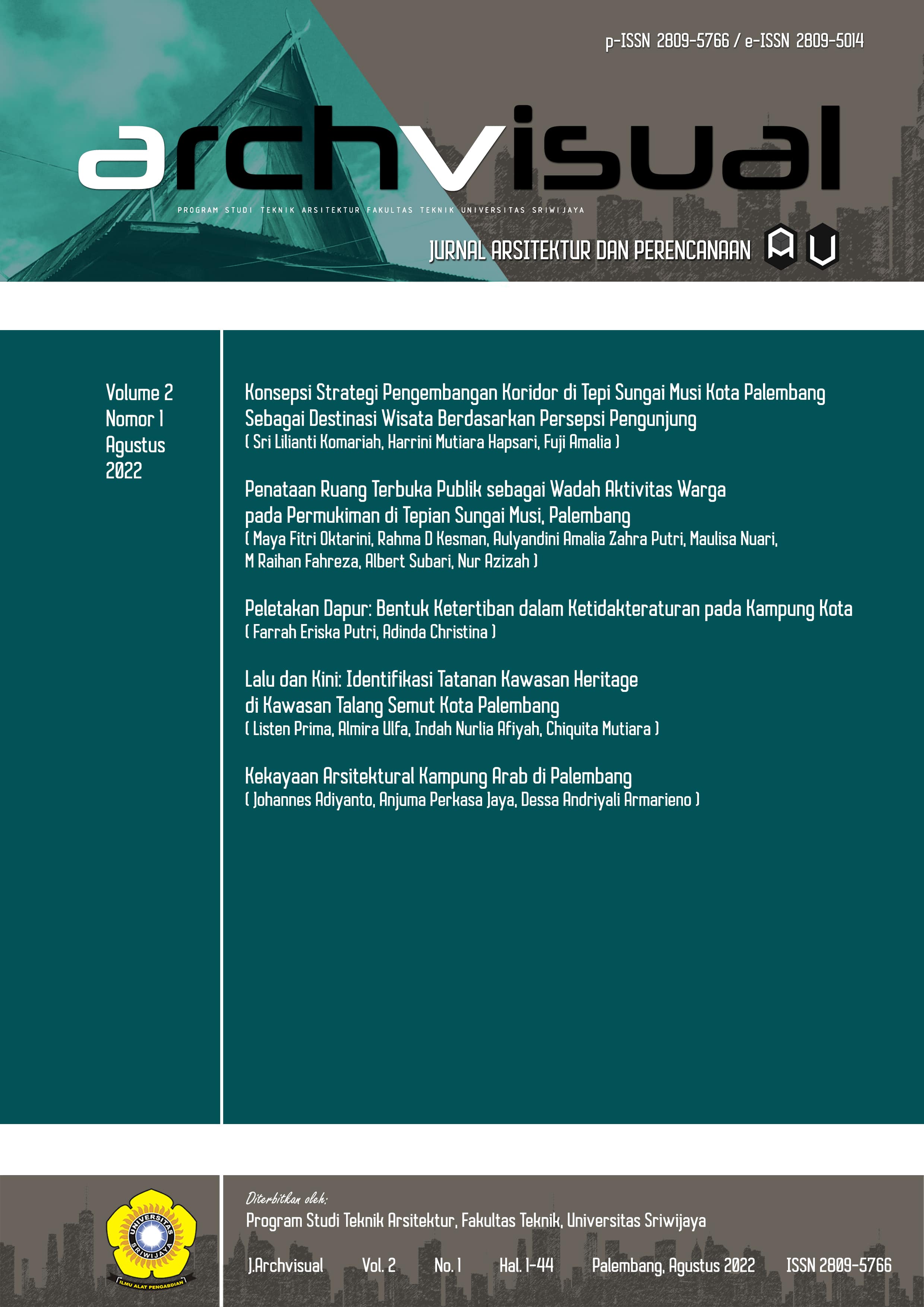Kekayaan Arsitektural Kampung Arab di Palembang (Kasus Kampung Al Munawar dan Kampung Assegaf)
Main Article Content
Abstract
Palembang is a historic city in Indonesia. Palembang serves as a port and a trading hub in addition. The Hadrami, who hailed from Hadramaut, were one tribe of traders who subsequently made Palembang their home. The Hadrami immigrants reside in the two historic villages of Al Munawar and Assegaf. In this study, architectural components in these two villages are used as signs that can be interpreted based on their denotation and connotation. This research method is known as semotics in architecture. This essay demonstrates how the socioeconomic proximity of the villagers to the ruling authorities at the time—namely the Palembang Darussalam Sultanate and the Dutch East Indies—is related to the shape of the buildings in these two villages. The result of the result would be a basis of next studies and also program of city development, especially in Palembang City.
Article Details
Section

This work is licensed under a Creative Commons Attribution-NonCommercial 4.0 International License.
How to Cite
References
Apriana (2020). Sejarah Kedatangan Arab Hadramaut ke Palembang.
Cartwright, M (2020) Leon Battista Alberti. World History. https://www.worldhistory.org/Leon_Battista_Alberti/
Handinoto (1998). Arsitektur gaya “Indo eropa” th. 1920 an di Indonesia. Dimensi Arsitektur, 26(26), Desember 1998, 1–9.
Nawiyanto, Eko Crys Endrayadi (2016) Kesultanan Palembang Darussalam – Sejarah Dan Warisan Budayanya, Jember University Press.
Peeters, J (1997) Kaum Tuo - Kaum Mudo: Perubahan Religius di Palembang 1821 - 1942. INIS.
Pellegrino, P (2006) Semiotics of Architecture. Encyclopedia of Language & Linguistics, December 2006, 212–216. https://doi.org/10.1016/B0-08-044854-2/01393-6
Prastiwi, R. E., Saraswati, U., & Witasari, N (2019) Sejarah Perkembangan Arsitektur Bangunan Indis di Purworejo Tahun 1913-1942. Journal of Indonesian History, 8(1), 88–95.
Purwanti, R. (2017). Pelestarian Kawasan Kampung Arab Almunawar Palembang. Seminar Ikatan Peneliti Lingkungan Binaan Indonesia (IPLBI), October, B089–B094. https://doi.org/10.32315/sem.1.b089
Siswanto, A (2009) Kearifan Lokal Arsitektur Tradisional Sumatera Selatan Bagi Pembangunan Lingkungan Binaan. Local Wisdom: Jurnal Ilmiah Kajian Kearifan Lokal, 1(1), 37–45.
Triyuly, W (2013) Pola Perkembangan Permukiman Kampung Assegaf Palembang. Berkala Teknik, 3(2), 508–517.
Uluğ, E (2020) An Investigation into the Connotations of Iconic Buildings by Using a Semiotic Model of Architecture. Social Semiotics, 32(2), 279–300. https://doi.org/10.1080/10350330. 2020.1756590
Wuisman, J. J. M (2007) “The Past in the Present: The Place and Role of Indonesian Vernacular Architectural Traditions and Building Styles of the Past in the Present.” In P. J. M. Nas (Ed.), The Past in the Present: Architecture in Indonesia. KITLV Press.
Yasraf A. Piliang (2015) Semiotika dalam Arsitektur. Https://Ar.Itb.Ac.Id/Id_id/Archives/2992.

